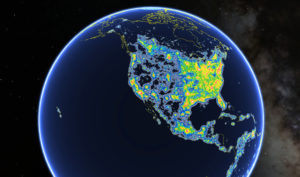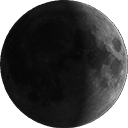
Jun 11
Light Pollution Hides Milky Way From 80 Percent Of North Americans

This view of North America as seen in Google Earth shows colored areas that denote levels of light pollution as detailed in the New World Atlas of Artificial Sky Brightness.
Fabio Falchi et al./AAAS
The luminous glow of light pollution prevents nearly 80 percent of people in North America from seeing the Milky Way in the night sky.
That’s according to a new atlas of artificial night sky brightness that found our home galaxy is now hidden from more than one-third of humanity.
While there are countries where the majority of people still live under pristine, ink-black sky conditions — places such as Chad, Central African Republic and Madagascar — more than 99 percent of the people living in the U.S. and Europe look up and see light-polluted skies.
The country with the worst light-pollution is Singapore, where researchers found that “the entire population lives under skies so bright that the eye cannot fully dark-adapt to night vision.”
Other countries with large percentages of people living under skies this bright include Qatar, Kuwait and the United Arab Emirates.



